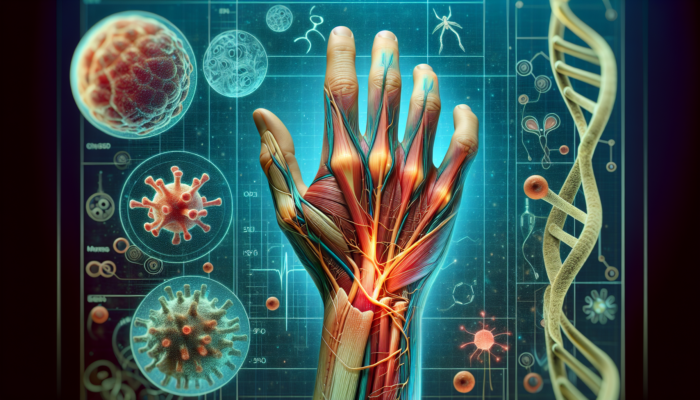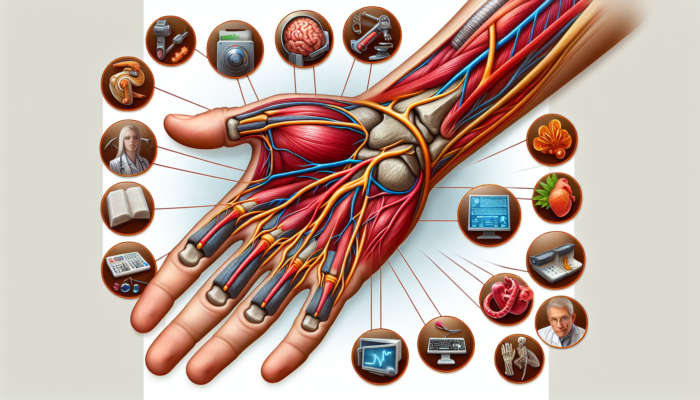Unlock the Life-Changing Benefits of Acupuncture for Alleviating Carpal Tunnel Syndrome Symptoms
Acupuncture has emerged as a highly regarded therapeutic option for individuals grappling with the debilitating effects of carpal tunnel syndrome. This ancient practice offers more than mere pain relief; it directly targets the fundamental causes of discomfort experienced by many. If you struggle with troubling sensations such as numbness, tingling, and weakness in your hands and wrists, gaining insight into how acupuncture for carpal tunnel relief works can transform your health journey. In this extensive article, we will delve into the complexities surrounding carpal tunnel syndrome, examine the crucial role of acupuncture in alleviating its symptoms, and unveil the numerous benefits available to those affected.
Understanding the Intricacies of Carpal Tunnel Syndrome

Gaining Comprehensive Insights into Carpal Tunnel Syndrome
Carpal tunnel syndrome (CTS) is a widespread condition that manifests as a variety of uncomfortable sensations in the hand and arm. This disorder occurs when the median nerve, which travels through the carpal tunnel located in the wrist, becomes compressed. Such compression of the nerve leads to symptoms that can significantly disrupt daily activities and diminish overall quality of life. Understanding this condition thoroughly is essential for anyone seeking effective treatment options, including acupuncture for carpal tunnel relief. By educating yourself on CTS, you can better navigate the path towards healing and improved health.
Recognising the Common Symptoms of Carpal Tunnel Syndrome
Individuals suffering from carpal tunnel syndrome often experience a distressing range of symptoms, which may include:
– Persistent pain that radiates from the wrist into the hand.
– Numbness or tingling sensations that extend to the fingers.
– Noticeable weakness in grip strength, making simple tasks like holding objects increasingly challenging.
These symptoms can severely disrupt sleep patterns and daily activities, prompting many individuals to seek effective solutions such as acupuncture for carpal tunnel relief to regain control of their lives and improve their overall well-being.
Examining the Causes and Risk Factors of Carpal Tunnel Syndrome

Understanding the underlying causes of carpal tunnel syndrome is vital for developing effective treatment and prevention strategies. Common risk factors contributing to the onset of this condition include:
– Repetitive hand usage: Activities that involve prolonged wrist flexion, such as typing or assembly line work, can significantly raise the likelihood of developing CTS.
– Wrist injuries: Previous trauma to the wrist may increase the risk of nerve compression and the subsequent emergence of symptoms.
– Health conditions: Certain medical issues, including diabetes, rheumatoid arthritis, and thyroid disorders, can heighten the chances of developing CTS.
By identifying these risk factors, individuals can empower themselves to take proactive measures to prevent the onset of symptoms and seek timely interventions when necessary.
Discovering How Acupuncture Can Provide Relief from Carpal Tunnel Syndrome
Grasping the Fundamental Principles of Acupuncture
Acupuncture is deeply embedded in the traditions of Traditional Chinese Medicine (TCM), which posits that a vital energy known as ‘qi’ flows through specific pathways within the body. By stimulating designated acupuncture points, practitioners aim to restore balance and alleviate pain. This ancient practice is more than just needle insertion; it represents a holistic approach to health that addresses both symptoms and the underlying imbalances contributing to the condition, facilitating a more comprehensive health experience.
Identifying Key Acupuncture Points for Effective Carpal Tunnel Syndrome Relief

Several specific acupuncture points have demonstrated remarkable effectiveness in delivering acupuncture for carpal tunnel relief. Notable points include:
– PC6 (Neiguan): Situated on the inner forearm, this point is recognised for its ability to alleviate wrist pain.
– LI4 (Hegu): Located on the hand, this point is widely acclaimed for its potent pain-relieving properties.
– TH5 (Waiguan): Found on the outer forearm, this point is effective in reducing inflammation.
Focusing on these critical points can enhance blood circulation and relieve nerve pressure, effectively addressing the symptoms linked to carpal tunnel syndrome and promoting a sense of relief.
Examining the Mechanism Behind Pain Relief Facilitated by Acupuncture
The effectiveness of acupuncture in alleviating pain predominantly stems from its ability to reduce inflammation and nerve pressure. By stimulating specific acupuncture points, the body releases endorphins, which are natural painkillers that induce relaxation and comfort. Additionally, acupuncture improves circulation, ensuring that essential nutrients reach the affected areas, thereby facilitating recovery and healing processes.
Research Evidence Supporting Acupuncture as a Viable Treatment for Carpal Tunnel Syndrome
A burgeoning body of academic research underscores the efficacy of acupuncture in treating carpal tunnel syndrome. Numerous studies indicate that patients undergoing acupuncture treatment report significant reductions in pain levels and enhancements in hand functionality. This compelling evidence positions acupuncture as a credible and effective alternative to conventional treatment options, offering hope to those in search of relief.
Revealing the Extensive Benefits of Acupuncture for Carpal Tunnel Syndrome Relief
The Allure of Non-Invasive Treatment Methods
One of the most appealing aspects of acupuncture is its non-invasive nature. Unlike surgical procedures, which can entail considerable risks and often necessitate lengthy recovery times, acupuncture presents a safer alternative that does not rely on medications or invasive techniques. This makes it an attractive choice for individuals seeking effective and compassionate relief from carpal tunnel syndrome.
Experiencing Significant Reductions in Pain and Inflammation
Many patients report immediate and sustained relief from pain and inflammation through acupuncture. Numerous individuals discover that their symptoms improve considerably after just a few sessions, making this treatment a compelling option for those seeking rapid and effective results.
Enhancing Hand Functionality and Dexterity through Regular Acupuncture Treatments
Consistent acupuncture sessions can lead to improvements in grip strength and hand dexterity, enabling individuals to resume daily tasks with greater ease and efficiency. This enhancement is particularly beneficial for those whose professions require fine motor skills, allowing them to perform their duties more effectively and with less discomfort.
Embracing a Holistic Approach to Health Through Acupuncture
Acupuncture perceives the body as an interconnected whole rather than merely isolating symptoms. This holistic perspective can facilitate overall health improvements, addressing not only the pain associated with carpal tunnel syndrome, but also any underlying imbalances that may exist, fostering a deeper sense of well-being.
Preparing for Your Acupuncture Session: Essential Steps to Ensure Success
Selecting a Qualified Acupuncturist for Optimal Treatment Outcomes
Choosing a certified and experienced acupuncturist is crucial for ensuring a successful treatment experience. Seek practitioners with relevant qualifications and positive patient testimonials. A skilled acupuncturist will have a profound understanding of the techniques and nuances involved in effectively treating carpal tunnel syndrome, thereby increasing the likelihood of achieving satisfactory outcomes.
What to Expect During Your First Acupuncture Consultation
During your initial consultation, the acupuncturist will conduct a thorough evaluation of your symptoms and medical history, crafting a personalised treatment plan tailored to your individual needs. Be prepared to discuss your specific concerns, as this information will aid in formulating a customised approach to your acupuncture for carpal tunnel relief.
Pre-Session Strategies to Maximise Your Acupuncture Experience
To enhance the effectiveness of your acupuncture experience, consider implementing the following pre-session strategies:
– Ensure proper hydration to support your body’s response to treatment.
– Avoid consuming caffeine, as it can hinder relaxation and comfort during the session.
– Wear loose-fitting clothing that allows easy access to acupuncture points.
These simple yet effective measures can greatly enhance the outcomes of your acupuncture session, establishing a solid foundation for successful treatment.
Exploring Advanced Acupuncture Techniques for Enhanced Carpal Tunnel Relief
Understanding the Nuances of Needle Insertion Techniques in Acupuncture
Acupuncturists employ various needle insertion methods, ranging from shallow to deep, depending on the specific acupoint targeted and the patient's comfort level. This flexibility ensures that each session is tailored to meet individual needs and preferences, maximising the potential benefits of treatment.
Enhancing Treatment Effects Through Electroacupuncture
Some practitioners incorporate electroacupuncture, which involves the application of electrical stimulation to the needles, thereby boosting treatment outcomes. This technique can amplify the effects of acupuncture, facilitating quicker pain relief and streamlining the body’s healing process.
Integrating Acupuncture with Cupping Therapy for Optimal Therapeutic Results
Combining acupuncture with cupping therapy can lead to superior therapeutic effects. Cupping therapy creates suction on the skin, enhancing blood flow and alleviating muscle tension, which complements the effects of acupuncture and improves overall treatment efficacy.
Utilising Moxibustion for Enhanced Therapeutic Relief
Moxibustion, which involves the application of heat to specific acupuncture points, can intensify the relief experienced. This method enhances circulation and alleviates discomfort, making it a valuable addition to acupuncture treatments for carpal tunnel syndrome.
Integrating Acupuncture with Complementary Therapeutic Strategies
Enhancing Outcomes by Combining Acupuncture with Physical Therapy
Pairing physical therapy with acupuncture can yield exceptional benefits. Targeted exercises designed to strengthen wrist and hand muscles can enhance the pain relief achieved through acupuncture, ultimately promoting better functionality and mobility for the affected areas.
Chiropractic Care: A Complementary Strategy to Enhance Acupuncture Treatment Results
Chiropractic adjustments can improve overall wrist and hand health by correcting any misalignments contributing to carpal tunnel syndrome. By merging chiropractic care with acupuncture, patients can optimise their treatment outcomes and achieve comprehensive relief.
Massage Therapy: A Synergistic Approach to Healing and Recovery
Massage therapy techniques can effectively diminish muscle tension and improve circulation, working in harmony with acupuncture to yield optimal results. Regular massage can help maintain the benefits of acupuncture sessions, supporting long-term relief and recovery.
Enhancing Acupuncture Outcomes with Herbal Medicine
Incorporating herbal medicine can further amplify the positive effects of acupuncture. Certain herbal supplements are known to aid in reducing inflammation and promoting healing, creating a holistic approach to managing carpal tunnel syndrome and its associated challenges.
Inspiring Success Stories: Real-Life Experiences with Acupuncture for Carpal Tunnel Syndrome
Case Study 1: A Musician's Inspiring Journey to Pain Relief and Recovery
Consider the motivating story of a musician who was burdened by debilitating wrist pain. After undergoing a series of acupuncture sessions, they experienced remarkable relief, enabling them to return to their passion for playing music without discomfort and rediscover their love for their craft.
Case Study 2: An Office Worker’s Triumph Over Chronic Wrist Pain
An office worker grappling with chronic wrist pain found success through acupuncture. With consistent treatments, they regained hand functionality, allowing them to perform their job duties without disruption, which significantly improved both productivity and overall quality of life.
Case Study 3: A Mother’s Experience of Relief During Pregnancy
A mother experiencing carpal tunnel symptoms during her pregnancy discovered that acupuncture provided her with invaluable relief. This non-invasive treatment option allowed her to navigate her pregnancy comfortably, greatly enhancing her overall well-being during this crucial period.
Case Study 4: An Athlete’s Journey Back to Peak Performance with Acupuncture
An athlete determined to achieve peak performance sought acupuncture to address persistent wrist pain. Following several sessions, they reported significant improvements, enabling them to return to training and competition, thus supporting their athletic aspirations and goals.
Addressing Your Frequently Asked Questions About Acupuncture for Carpal Tunnel Syndrome Relief
What Is the Recommended Frequency of Acupuncture Sessions for Optimal Results?
Typically, a range of 6-12 sessions is suggested for achieving considerable relief; however, the precise number may vary based on the severity of symptoms and individual responses to treatment.
Is the Acupuncture Procedure Painful or Uncomfortable?
Most patients experience minimal discomfort during acupuncture sessions, often describing the sensation as a slight prick or mild tingling, which is generally well-tolerated.
Can Acupuncture Completely Cure Carpal Tunnel Syndrome?
While acupuncture may not provide a complete cure for carpal tunnel syndrome, it can significantly alleviate symptoms and enhance overall well-being, making it a valuable part of a comprehensive treatment plan.
Are There Any Potential Side Effects Associated with Acupuncture?
Side effects are rare; however, they may include bruising or soreness at the needle insertion sites, which typically resolves quickly following treatment.
How Long Can I Expect the Results of Acupuncture to Last?
The duration of results can vary; however, many patients report enjoying long-term relief, especially with regular maintenance sessions to sustain the benefits.
Connect with us on Facebook for More Insights and Updates!
The Article: Acupuncture for Carpal Tunnel: Essential Relief Guide appeared first on https://mcrtherapies.co.uk
The Article Acupuncture for Carpal Tunnel: Your Essential Relief Guide appeared first on https://mcrtherapies.com
The Article Acupuncture for Carpal Tunnel: Essential Relief Strategies Was Found On https://limitsofstrategy.com

